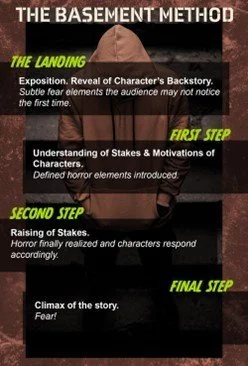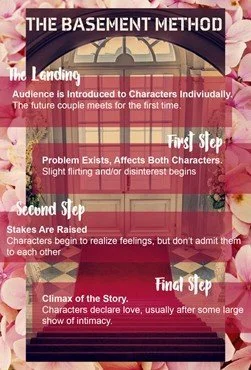The Basement Method in Horror and Other Fiction Genres
Have you ever been in a situation that felt like life or death?
You rear-ended someone and immediately you started thinking of the trouble with the insurance company, the reaction of the other driver, etc.
Or do your test scores come back, and you will fail the whole class if you don’t pass this one test?
These are all moments of tension that don’t have the same stakes as say a climax would.
They can help build up an audience to keep reading a story.
However, tension can often be one of the most challenging elements to incorporate into a scene, whether it is in the horror genre or not. I will show you how there is a way to create real tension with the basement method.
WHY TENSION IS IMPORTANT
Before I dive into this method, let me explain why tension in the story matters. Let us take one of the above examples and turn it into the opening of a short scene.
Here is that story with tension:
Christina bit down on the bottom of her lip. Not hard enough to hurt, but hard enough to quell the ball of anxiety that gripped her chest. The professor distributed tests. He snaked his long, lean body down the row of students, placing the test face down, one desk at a time. Someone coughed. The clock ticked with an echo that seemed to radiate the students. This test would be the sole determiner of whether Christina passed the course. A course she desperately needed to pass so that she could graduate. Two rows now.
Christina's knee twitched, then spasmed into short, steady shakes. Her nails tapped against the worn wood. Closer now. Finally, the professor placed the test down, and before he turned around completely, she snatched it up and braced herself. C+! She passed.
And here is that story without:
The professor walked over to Christina and placed the paper down in front of her. If she failed this test, she would fail the whole class. She gulped. An C+! She passed the test and the course.
Which story is more enjoyable?
In both, the test's grade will impact whether she passes or fails, but the first story is satisfying. This is because the first story has an air of tension, and with this added pressure the audience has time to question the outcome. Will she get an F? Will she barely pass? So on.
Tension allows the audience to understand the conflict, but they can better immerse themselves in the world the author has presented.
WHAT IS THE BASEMENT METHOD?
After creating psychological horror stories in 2013, I started developing a specific method for thinking about tension in fiction. This method became the Basement Method when I wrote my undergraduate thesis, Exploring Horror Narratives in Literature and Film.
I wanted a visual reminder of how to tackle tension with each scene and the overall story. I was already using a pressure and time graph, but the Basement Method is only concerned with timing pacing within scenes or the larger story.
Consider the way that a basement looks.
Or how most basements look.
While the light switch can sometimes be at the top, let us pretend that the light switch is at the bottom, so you must descend into the unknown.
Anything can be down there. It can be a creepy clown, a giant spider, or you could be walking into a flooded basement because your washing machine broke, and now you will have to buy a new one for hundreds of dollars, if not more. The clown or spider might be less scary than this.
The fear of the unknown is frequently more powerful and scarier than the reality of what is lurking in the dark basement. With each step, the fear intensifies, and that is how your story should descend.
Like so:
The thought of what might happen is so helpful in horror.
You do not want to reveal your hand immediately; it must be a slow descent.
Plenty of films and literature get this wrong by throwing a jump scare or a scary description here or there.
The most effective horror is slow, the pacing is inclined, and when the jump scare does happen – it is terrifying!
Watch the video below to see how the Basement Method affects horror specifically:
DOES THE BASEMENT METHOD WORK IN OTHER GENRES?
Although I created the Basement Method for use in the horror genre, it can apply to any genre. For instance, if you were thinking about writing a romance, your basement may look something like this:
While this does not depict every romance story, it does represent a typical fictional structure for this genre. After the characters meet each other, they may start flirting or pretend to despise each other, though the audience knows there is some attraction.
There is then some problem that affects both characters. For instance, one character may have to find a date for a family wedding, or one character must find someone to love before a terrible spell. While this problem can predominately affect one character because they are attracted to each other, it inadvertently affects them both.
The rest of the story revolves around these two characters falling in love, stopping the problem, and then resisting that love until it is too love. There can be several reasons why they fight for love, but it is part of the conflict.
It is also important to note that you do not have to have four steps in your basement structure. Any number of steps you need to map out the tension level is sufficient.
You also do not have to think about a "basement" to understand these connections, but as mentioned, I like to have a visual element to my stories when I plot. It helps me understand the bigger picture.
While there are additional methods and elements that you can use to write horror, such as a tension and time graph, or simply learning from other horror authors, the above will give you an excellent platform to think critically about writing in the genre.

































Learn how to write believable horror protagonists readers care about, with tips and examples from horror films and classic literature.